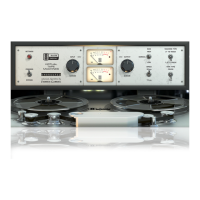
Do you have a question about the Slate Digital Virtual Tape Machines 1.1 and is the answer not in the manual?
| Version | 1.1 |
|---|---|
| Platform | Mac, Windows |
| Type | Audio Plugin |
| Plugin Formats | VST, AU, AAX |
| RAM | 4 GB minimum |
| Sample Rate | Up to 192 kHz |
| Noise Reduction | Yes |
| Input/Output Trim | Yes |
| Bias Control | Yes |
| Flutter Control | Yes |
| Head Bump Control | Yes |
| Harmonic Distortion | Yes |
| Phase Alignment | Yes |
| Latency Compensation | Yes |
| Presets | Yes |
| Operating System | Windows 7 or later, macOS 10.8 or later |
| Mono/Stereo | Stereo |
Details the 2-inch 16-track and 1/2-inch 2-track tape machines modeled.
Explains the FG456 and FG9 tape formulations and their sonic characteristics.
Discusses the 15ips and 30ips tape speeds and their sonic differences.
Explains the Normal, High, and Low bias settings and their effect on frequency response and saturation.
Describes the Input/Output level controls and the Input/Output Link function for gain monitoring.
Explains the Group Assignment Selector and the Process/Bypass switch for managing multiple instances.
Details the selectors for Machine Type, Tape Type, Tape Speed, and Bias.
Covers adjusting tape hiss and pitch/amplitude variations for desired sonic character.
Explains fine-tuning low-end response and VU meter reaction speed.
Details the hiss muting feature and setting default group assignments for quick setup.
Initial steps for inserting the plugin on tracks and assigning them to groups for synchronized control.
Guidance on selecting Tape Machine, Type, Speed, and Bias for all grouped instances.
Describes basic and advanced uses of groups, including hybrid tape machine configurations.
Covers setting default groups for new instances and bypassing processing for entire groups.
Details how to unlink and adjust gain stages for individual tracks within a group.
Explains the possibility of automating parameters for grouped VTM instances across tracks.
Guidance on how much to 'hit' the tape to achieve desired distortion and noise/saturation ratio.
Outlines a typical signal chain for mixing with VTM and other Slate Digital plugins.
Details how to adjust calibration levels to control tape saturation and signal-to-noise ratio.
Explains the rationale behind the default calibration settings and their relation to real tape machines.
Explains the function of VU meters and the clipping LED for monitoring signal levels and saturation.
Discusses the modeled tape hiss and how to adjust it using the Noise Reduction slider.
Describes how Bass Alignment affects the low-end response and sub-bass frequencies of the modeled tape machines.
Explains the emulation of pitch and amplitude variations inherent in tape machines.
Covers the hiss muting feature and the selection of VU meter reaction speeds.
Lists keyboard shortcuts for resetting parameters, fine adjustments, and automation dialogs.
Details the 'Save' and 'Save As' functions, as well as importing/exporting preset banks.
Explains how to move between presets and use snapshot slots for quick recall of settings.
Describes how to hide the spinning reels for a cleaner interface.
Step-by-step guide to downloading and activating the plugin license using the iLok License Manager.
Instructions for installing the VTM plugin on both Mac and Windows operating systems.
Outlines the required CPU, RAM, iLok, and OS for PC users.
Outlines the required CPU, RAM, iLok, and OS for Mac users.
Informs about the fee associated with transferring iLok licenses for reselling software.
Guidance on logging inquiries through the help desk and selecting the appropriate category.
Instructions on how to collect and provide system and plugin information for troubleshooting.
Explains the mission to create faithful sound replicas rather than mere imitations, focusing on accuracy and behavior.
Details the scientific testing and listening tests used to refine algorithms for accurate tape emulation.